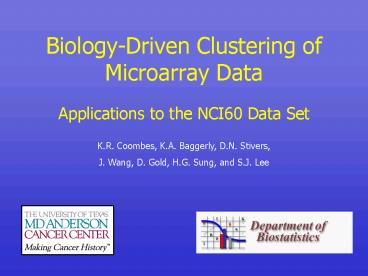BiologyDriven Clustering of Microarray Data PowerPoint PPT Presentation
Title: BiologyDriven Clustering of Microarray Data
1
Biology-Driven Clustering of Microarray Data
- Applications to the NCI60 Data Set
K.R. Coombes, K.A. Baggerly, D.N. Stivers, J.
Wang, D. Gold, H.G. Sung, and S.J. Lee
2
Introduction
- Microarray data is more than a large,
unstructured matrix. - We already know many genes important for studying
cancer through their involvement in specific
biological processes - We also know that reproducible chromosomal
abnormalities play an important role in cancer - Need analytical methods that use biological
information early
3
Methods
- First, updated the annotations of the genes on
the microarray - Performed separate analyses
- using genes on individual chromosomes
- using genes involved in different biological
processes - Developed ways to assess how well each set of
genes classified samples
4
Quality of Annotations
- Problem
- I.M.A.G.E. clone IDs and GenBank accession
numbers are archival - UniGene clusters, gene names, descriptions,
functions, etc., are changeable - Solution
- Download latest UniGene (build 137) and LocusLink
to update annotations
5
How many genes on the array have good annotations?
Only trust the 7478 spots where the UniGene
clusters match.
6
Where are the genes located?
7
How do we determine the functions of genes?
- UniGene -gt LocusLink -gt GeneOntology
- GeneOntology is a structured, hierarchical
vocabulary to describe gene functions in three
broad areas - biological process (why)
- molecular function (what)
- cellular component (where)
8
What kinds of genes are on the microarray?
9
Data Preprocessing
- Remove spots with poor annotations and spots with
median intensity below the 97th percentile of
empty spots. - Normalize each array so median log ratio between
channels is one - Center each gene so mean log ratio across
experiments is zero - Use (1-correlation)/2 as distance metric
10
How well does a set of genes distinguish types of
cancer?
- Three methods for assessment
- Qualitative (PCA, MDS)
- Quantitative (PCA ANOVA)
- Semi-quantitative (Grading Dendrograms)
11
Multidimensional Scaling
12
PCANOVA
13
How good is a dendrogram?
- A cluster contains all and only one kind of
cancer - B all, with extras
- C all except one
- D all except one, with extras
- E all except two
- F all except two, with extras
14
Can cancers be distinguished by genes on one
chromosome?
15
Heterogeneity of different types of cancer
- Some cancers (colon, leukemia) are fairly easy to
distinguish from others - Some (breast, lung) are so heterogeneous as to be
almost impossible to distinguish - Some chromosomes (1, 2, 6, 7, 9, 12, 17) can
distinguish many cancers. - Some (16, 21) are essentially random
16
(No Transcript)
17
(No Transcript)
18
Can cancers be distinguished by genes of one
function?
- Table for functional categories looks a lot like
the table for chromosomes - Some biological process categories (signal
transduction, cell proliferation, cell cycle,
protein metabolism) can distinguish many types of
cancer - Others (apoptosis, energy pathways) cannot
19
(No Transcript)
20
(No Transcript)
21
(No Transcript)
22
(No Transcript)
23
Conclusions (I)
- Multiple views into the data provide substantial
insight into differences in cancer types and gene
sets. - Cancer types differ greatly in their degree of
heterogeneity, ranging from homogeneous (colon,
leukemia) through moderately heterogeneous
(renal, melanoma) to extremely heterogeneous
(breast and lung).
24
Conclusions (II)
- Homogeneous cancers exhibit strong identifying
signals across most views of the data. - There are large difference in the ability of
genes of different chromosomes or involved in
different biological processes to distinguish
cancer types.
25
Supplementary Material
- Complete results of each analysis by chromosome
and by function are available no our web site - http//www.mdanderson.org
- /depts/cancergenomics

